Nissan Juke Service and Repair Manual : Clutch disc and clutch cover
Except for K9K : Exploded View
HR16DE
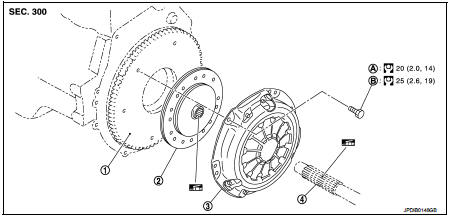
1. Flywheel
2. Clutch disc
3. Clutch cover
4. Input shaft
A. First step
B. Final step
 : N·m (kg-m, ft-lb)
: N·m (kg-m, ft-lb)
 : Apply lithium-based grease
: Apply lithium-based grease
including molybdenum disulphide.
MR16DDT
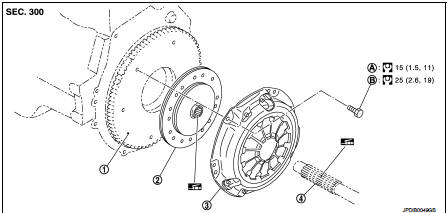
1. Flywheel 2. Clutch disc 3. Clutch cover 4. Input shaft
A. First step B. Final step
 : N·m (kg-m, ft-lb)
: N·m (kg-m, ft-lb)
 : Apply lithium-based grease
: Apply lithium-based grease
including molybdenum disulphide.
Except for K9K : Removal and Installation
CAUTION:
• Never reuse CSC (Concentric Slave Cylinder). Because CSC slides back to the
original position
every time when removing transaxle assembly. At this timing, dust on the sliding
parts may damage
a seal of CSC and may cause clutch fluid leakage. Refer to CL-27, "Removal and
Installation".
• Never bring any grease to the clutch disc facing, pressure plate surface and flywheel surface.
• Never clean clutch disc using solvent.
REMOVAL
1. Remove transaxle assembly. Refer to TM-30, "Removal and Installation" (RS5F92R), or TM-84, "MR16DDT : Removal and Installation" (RS6F94R).
2. Remove clutch cover mounting bolts while holding clutch cover.
CAUTION:
Never drop clutch disc.
3. Remove clutch cover and clutch disc.
CAUTION:
Never drop clutch disc
.
INSTALLATION
1. Clean clutch disc and input shaft splines to remove grease and powder arisen from abrasion.
2. Apply recommended grease to clutch disc (1) and input shaft (2) splines (A).
CAUTION:
Be sure to apply grease to the points specified. Otherwise,
noise, poor disengagement, or damage to the clutch may
result. Excessive grease may cause slip or judder. And if it
adheres to seal of CSC, it cause clutch fluid leakage. Wipe
out excess grease. Wipe out any grease oozing from the
parts
.
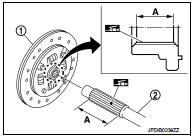
3. Install clutch disc, using a clutch aligner (A) [Commercial service tool].
4. Install clutch cover, and then temporarily tighten clutch cover mounting bolts.
5. Tighten clutch cover mounting bolts to the specified torque evenly in two steps in the numerical order as shown in the figure.
6. For the next step and after, install in the reverse order of removal.
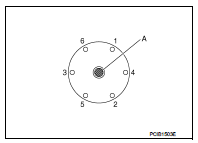
Except for K9K : Inspection
NSPECTION AFTER REMOVAL
Clutch Disc
• Measure circumferential runout relative to clutch disc center spline.
If it is outside the specification, replace clutch disc.
Runout limit/diameter of the area to be measured : Refer to CL-35, "Clutch Disc".
• Measure backlash to clutch disc spline and main drive gear spline at the circumference of clutch disc. If it is outside the specification, replace clutch disc.
Maximum allowable spline backlash (at outer edge of disc) : Refer to CL-35, "Clutch Disc".
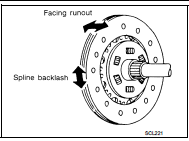
• Measure the depth “A” to clutch disc facing rivet heads, using a calipers. If it exceeds the allowable wear limit, replace clutch disc.
Facing wear limit (depth to the rivet head) “A” : Refer to CL-35, "Clutch Disc".
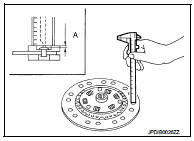
Clutch Cover
• Check clutch cover thrust ring for wear or breakage. If wear or breakage is
found, replace clutch cover.
NOTE
:
• Worn thrust ring will generate a beating noise when tapped at the rivet with a
hammer.
• Broken thrust ring will make a clinking sound when cover is shaken up and down.
• If a trace of burn or discoloration is found on the clutch cover pressure plate to clutch disc contact surface, repair the surface with sandpaper. If surface is damaged or distorted, replace clutch cover.
INSPECTION AFTER INSTALLATION
Clutch Cover Check diaphragm spring lever claws for unevenness with the lever still on the vehicle. If they exceed the tolerance, adjust lever height, using the diaphragm adjusting wrench (A) [SST: ST20050240].
Tolerance for diaphragm spring lever unevenness : Refer to CL-36, "Clutch Cover".
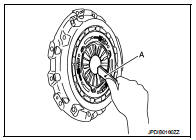
K9K : Exploded View
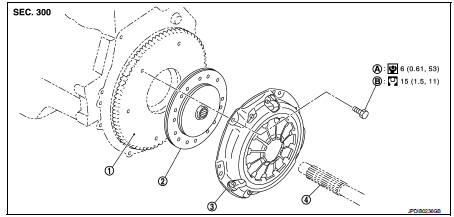
1. Flywheel
2. Clutch disc
3. Clutch cover
4. Input shaft
A. First step B. Final step
 : N·m (kg-m, ft-lb)
: N·m (kg-m, ft-lb)
 : N·m (kg-m, in-lb)
: N·m (kg-m, in-lb)
K9K : Removal and Installation
CAUTION:
• Never reuse CSC (Concentric Slave Cylinder). Because CSC slides back to the
original position
every time when removing transaxle assembly. At this timing, dust on the sliding
parts may damage
a seal of CSC and may cause clutch fluid leakage. Refer to CL-27, "Removal and
Installation".
• Never bring any grease to the clutch disc facing, pressure plate surface and flywheel surface.
• Never clean clutch disc using solvent.
REMOVAL
1. Remove transaxle assembly. Refer to TM-86, "K9K : Removal and Installation".
2. Remove clutch cover mounting bolts while holding clutch cover.
CAUTION:
Never drop clutch disc.
3. Remove clutch cover and clutch disc.
CAUTION:
Never drop clutch disc.
INSTALLATION
1. Clean clutch disc and input shaft splines to remove powder arisen from abrasion.
2. Install clutch disc, using a clutch aligner (A) [Commercial service tool].
3. Install clutch cover, and then temporarily tighten clutch cover mounting bolts.
4. Tighten clutch cover mounting bolts to the specified torque evenly in two steps in the numerical order as shown in the figure.
5. For the next step and after, install in the reverse order of removal.
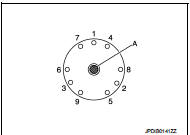
K9K : Inspection
INSPECTION AFTER REMOVAL
Clutch Disc
• Measure circumferential runout relative to clutch disc center spline.
If it is outside the specification, replace clutch disc.
Runout limit/diameter of the area to be measured : Refer to CL-35, "Clutch Disc".
• Measure backlash to clutch disc spline and main drive gear spline at the circumference of clutch disc. If it is outside the specification, replace clutch disc.
Maximum allowable spline backlash (at outer edge of disc) : Refer to CL-35, "Clutch Disc".
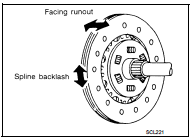
• Measure the depth “A” to clutch disc facing rivet heads, using a calipers. If it exceeds the allowable wear limit, replace clutch disc
Facing wear limit (depth to the rivet head) “A” : Refer to CL-35, "Clutch Disc".
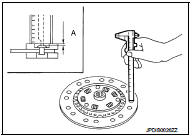
Clutch Cover
• Check clutch cover thrust ring for wear or breakage. If wear or breakage is
found, replace clutch cover.
NOTE
:
• Worn thrust ring will generate a beating noise when tapped at the rivet with a
hammer.
• Broken thrust ring will make a clinking sound when cover is shaken up and down.
• If a trace of burn or discoloration is found on the clutch cover pressure plate to clutch disc contact surface, repair the surface with sandpaper. If surface is damaged or distorted, replace clutch cover.
INSPECTION AFTER INSTALLATION
Clutch Cover
Check diaphragm spring lever claws for unevenness with the lever
still on the vehicle. If they exceed the tolerance, adjust lever height,
using the diaphragm adjusting wrench (A) [SST: ST20050240].
Tolerance for diaphragm spring lever unevenness : Refer to CL-36, "Clutch Cover".
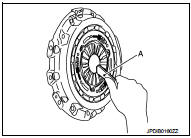
 CSC (concentric slave cylinder)
CSC (concentric slave cylinder)
Exploded View
1. Transaxle assembly
2. CSC (Concentric Slave Cylinder)
: Always replace after every
disassembly.
: N·m (kg-m, ft-lb)
Removal and Installation
CAUTION:
• Never reuse CSC (Co ...
Other materials:
U1010 control unit (CAN)
Description
CAN (Controller Area Network) is a serial communication line for real time
application. It is an on-vehicle multiplex
communication line with high data communication speed and excellent error
detection ability. Many electronic
control units are equipped onto a vehicle, and each co ...
Engine block heater (if so equipped)
Engine block heaters are used to assist in cold temperature starting.
The engine block heater should be used when the outside temperature is 208F (−78C)
or lower.
To use the engine block heater
1. Turn the engine off.
2. Open the hood and unwrap the engine block heater cord.
3. Plug the ...
P0138 HO2S2
DTC Logic
DTC DETECTION LOGIC
The heated oxygen sensor 2 has a much longer switching time between rich and
lean than the air fuel ratio (A/
F) sensor 1. The oxygen storage capacity of the three way catalyst (manifold)
causes the longer switching
time.
MALFUNCTION A
To judge the malfuncti ...

